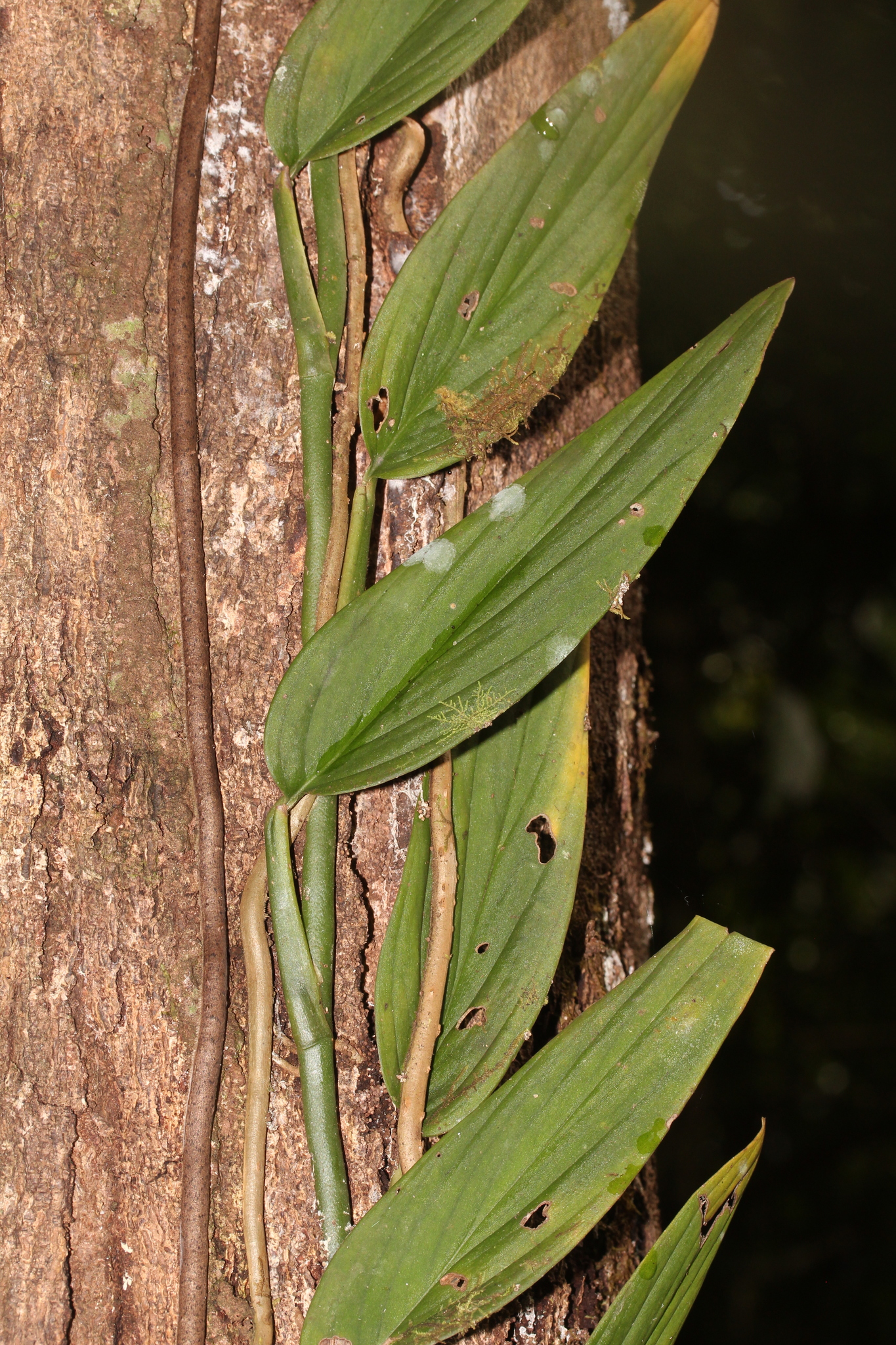Monstera barrieri
#热植图鉴#热带loveplants2024-05-03
Monstera barrieri,天南星科,热带植物,龟背竹图鉴,热带loveplants
 基本信息 General Information
Accepted Name:Monstera barrieri Croat, Moonen & Poncy
首次发布于:Rodriguésia 56: 61 (2005)
中文名称:龟背竹
科:天南星科
属:龟背竹属
原产地:法属圭亚那
命名者:Croat, Moonen & Poncy
植物简介 Descriptions
半附生植物,攀附于树上可达 10 米高;幼株叶片具叶柄,不重叠;茎干燥后变黑,有紧密且锐利的脊;叶柄长 2 - 2.5 厘米,几乎全部具鞘,边缘向内卷曲,鞘顶端至少一侧狭窄圆形,游离部分有明显的槽;叶片近革质,狭矩圆状披针形,长 5.5 - 厘米,长为宽的 5 倍,两面干燥后无光泽;未成熟植株叶柄长 6.5 - 9 厘米,几乎到顶端都狭鞘状;未成熟叶片狭卵状披针形,长 17.5 - 18.5 厘米,宽 21 - 21 厘米,深 4 - 6 裂,宽 4.3 - 6 厘米,长为宽的 2.9 - 4.2 倍,羽状浅裂,有 1 - 4 个狭窄裂片,裂至或几乎裂至基部;成年植株茎不对称,直径达 2 厘米;节间短于宽;叶柄(13)18 - 41 厘米长,在距叶片基部 8 厘米内具鞘;
基本信息 General Information
Accepted Name:Monstera barrieri Croat, Moonen & Poncy
首次发布于:Rodriguésia 56: 61 (2005)
中文名称:龟背竹
科:天南星科
属:龟背竹属
原产地:法属圭亚那
命名者:Croat, Moonen & Poncy
植物简介 Descriptions
半附生植物,攀附于树上可达 10 米高;幼株叶片具叶柄,不重叠;茎干燥后变黑,有紧密且锐利的脊;叶柄长 2 - 2.5 厘米,几乎全部具鞘,边缘向内卷曲,鞘顶端至少一侧狭窄圆形,游离部分有明显的槽;叶片近革质,狭矩圆状披针形,长 5.5 - 厘米,长为宽的 5 倍,两面干燥后无光泽;未成熟植株叶柄长 6.5 - 9 厘米,几乎到顶端都狭鞘状;未成熟叶片狭卵状披针形,长 17.5 - 18.5 厘米,宽 21 - 21 厘米,深 4 - 6 裂,宽 4.3 - 6 厘米,长为宽的 2.9 - 4.2 倍,羽状浅裂,有 1 - 4 个狭窄裂片,裂至或几乎裂至基部;成年植株茎不对称,直径达 2 厘米;节间短于宽;叶柄(13)18 - 41 厘米长,在距叶片基部 8 厘米内具鞘;
其特征是羽状浅裂、干燥后呈黑色的叶片,小叶细长,顶端狭窄地渐尖,基部完全不收缩。此外,兜状的佛焰苞以及肉穗花序和雌蕊横切面的亮红色也是其特征。
该物种在干燥时的叶子呈黑褐色以及质地方面与美脉花烛最为相似,但那个物种的叶片只是有穿孔,不是羽状的,并且有一个直的佛焰苞,长度不到 8 厘米。它也与羽裂美脉花烛相似,这是一种有羽状浅裂叶子且干燥时也呈黑色的物种,但该物种仅限于亚马逊河上游流域,并且有多达 12 个向中脉收缩的裂片。
Hemiepiphyte to 10 m high in trees; juvenile plants with blades petiolate, not shingled; stem drying blackened, closely and acutely ridged; petioles 2–2.5 cm long, sheathed almost throughout, the margins turned inward, the sheath apex narrowly rounded at least on one side, the free portion sharply sulcate; blades subcoriaceous, narrowly oblong-lanceolate, 5.5– cm long, 5 times longer than wide, drying matte on both surfaces; pre-adult plants with petioles 6.5–9 cm long, narrowly sheathed almost to the apex; pre-adult blades narrowly ovate-lanceolate 17.5–18.5 cm long, 21–21 cm wide, deeply 4–6-lobed, 4.3–6 cm wide, 2.9– 4.2 times longer than wide, pinnately lobed with 1–4 narrow lobes divided to or almost to the base; adult plants with stem assymetrical, to 2 cm diam.; internodes shorter than broad; petioles (13)18–41 cm long, sheathed to within 8 cm of base of blade; blades 36–58 cm long; 31–37 cm wide; pinnae 7–9 pairs, 17–26 cm long, 0.6–1.8 cm wide, 2–6 cm apart, most with a single medial rib, sometimes 2-ribbed, the upper edge ending abruptly on the midrib, the lower margin broadly confluent on the midrib and ending usually near the emergence of the next lower lobe; upper surface drying blackened and matte, minutely papillate; lower surface drying blackish yellow-brown, weakly glossy and only slightly paler; midrib obtusely sunken and concolorous above (drying deeply sunken), drying narrowly and obtusely raised and slightly brownish below; primary lateral veins 2–4 per side, arising at 15–20° angle, drying darker than surface, acute to bluntly raised, with numerous whitish linear cellular inclusions; sinus narrowly linear-lanceolate in outline; lateral lobes 2–12 mm wide, narrowly tapering to an acicular apex, sometimes still weakly connecting to the adjacent segment. Inflorescences 2 per axil; peduncle medium-dark green, (12)16.5–19 cm long, to 1 cm diam., to 6 mm diam. on drying, blackened; spathe creamy white, matte outside, only slightly paler inside, moderately coriaceous, markedly cucullate with the apical portion directed forward and hooding the opening, 15–23 cm long, 4.5 cm wide at anthesis (flattening to 11 cm wide), weakly convolute at the base for up to 2.5 cm with the lateral margins markedly folded and with the apical ½ protruding forward at almost a 90° to the axis of the spathe, acuminate at apex; spadix cylindroid, weakly tapered toward both ends, narrowly rounded at apex, 6–13 cm long, 2 cm diam., creamy white, deep wine-red to orange in cross-section, drying blackened, 9–12 cm long, 1.8–2 cm diam. at maturity, the axis ca. 7 mm wide; pistils ca. 7 mm long, creamy white; style about as broad as the pistil, tapered weakly to a nipple-like stigma; stamens white, held at about 2/3 the length of the pistils; anthers with thecae oblong, closely parallel, ca. 3 mm long; unripened. Infructescence pale green, sometimes with the old spathe persisting from base, the berries acute at apex.
Characterized by its pinnately lobed, blackish-drying blades with slender pinnae that are narrowly long-tapered toward the apex and not at all constricted toward the base. Also characteristic is the cuculate spathe and the bright reddish color of the cross-section of both the spadix and the pistils.
The species is most similar to M. expilata Schott in its blackish coloration and texture of the leaves on drying, but that species has blades that are merely perforate, not pinnate and a straight spathe less than 8 cm long. It is also similar to M. subpinnata (Schott) Engler, a species that has pinnately lobed leaves that also dry black, but that species is restricted to the upper Amazon basin and has up to 12 lobes that are constricted toward the midrib.
植物图片 Images

幼年期 Juvenility

生长期 Growth period

成熟期 Maturity

 图册
扩展阅读
参考资料
植物标本
图册
扩展阅读
参考资料
植物标本





